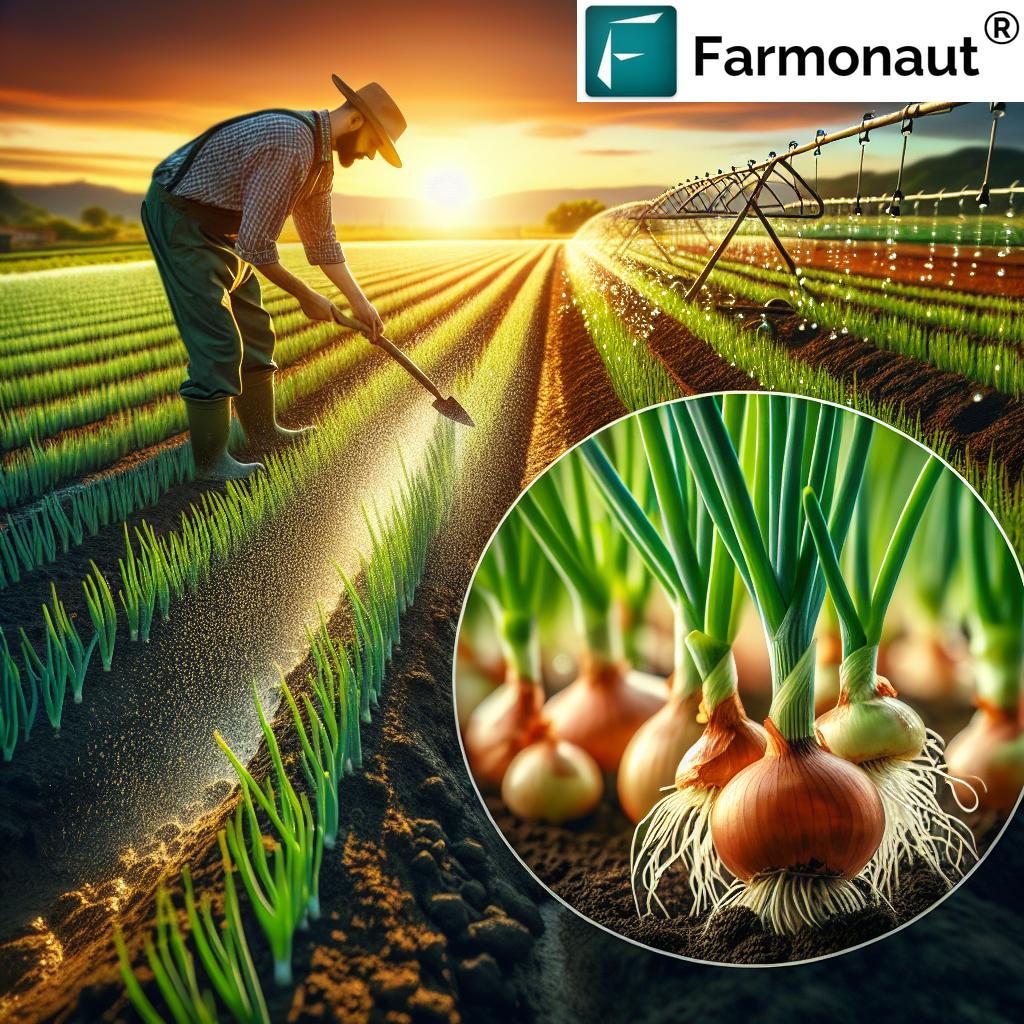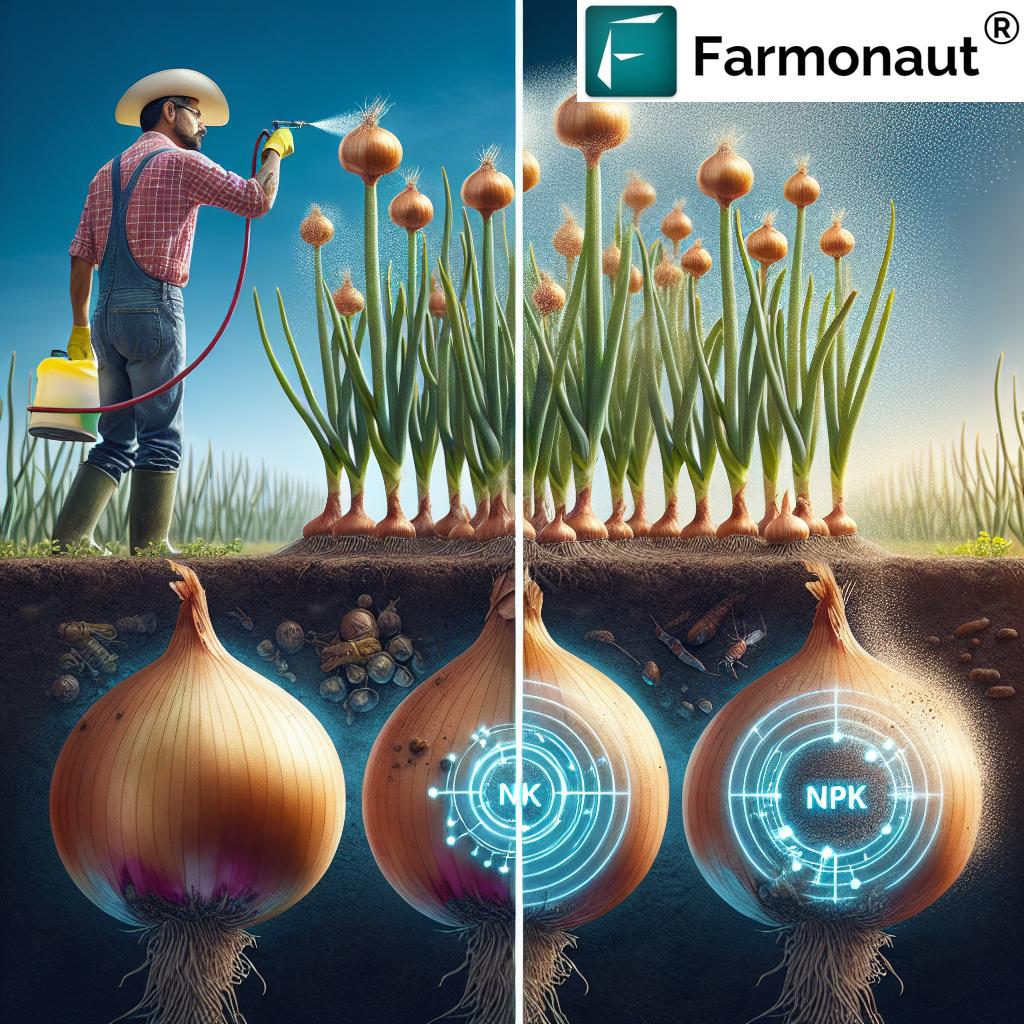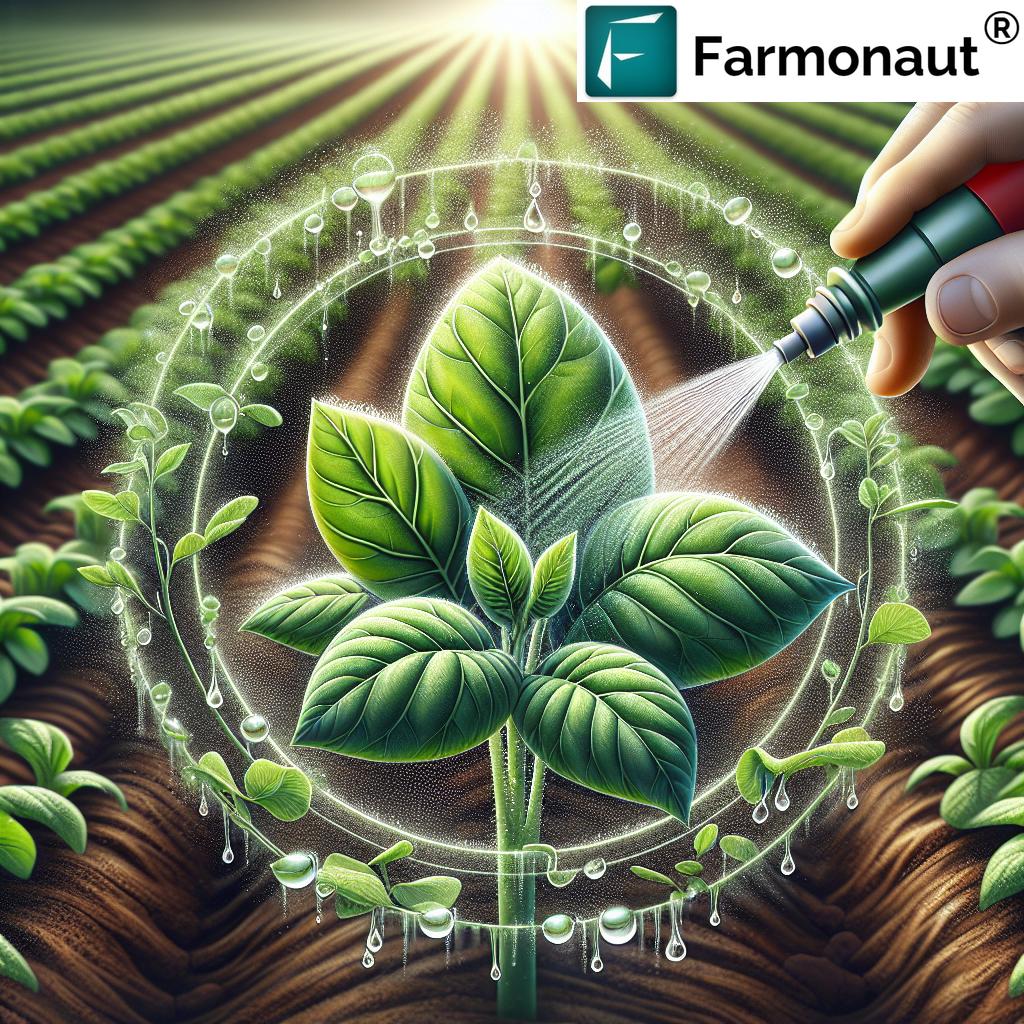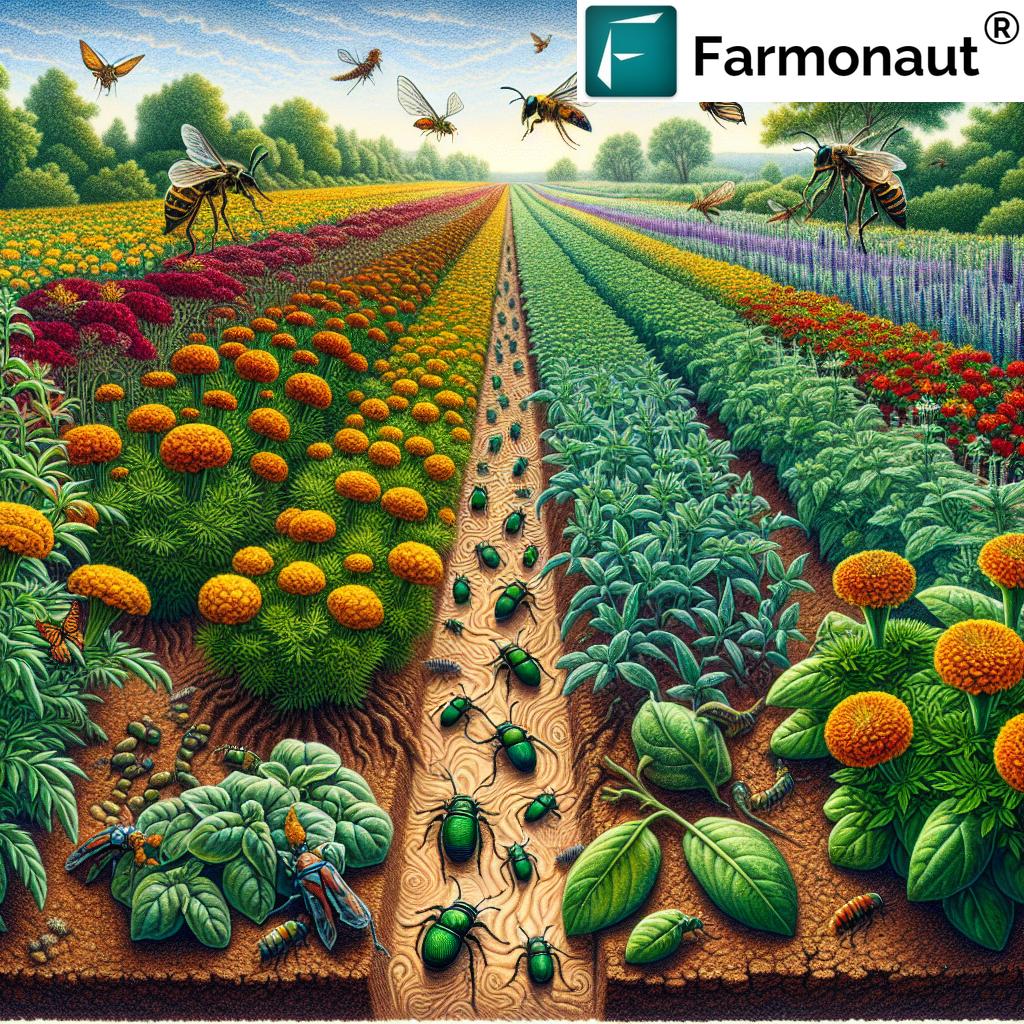Ultimate Guide: Maximize Onion Crop Yield with Expert Transplanting, Disease Prevention, and Nutrient Management Techniques
Welcome to our comprehensive guide on maximizing onion crop yield through expert transplanting, disease prevention, and nutrient management techniques. At Farmonaut, we’re committed to helping farmers achieve the best results with their onion crops using cutting-edge agricultural technology and sustainable farming practices. In this blog post, we’ll explore essential crop growth management strategies that will help you boost your onion productivity from seed to harvest.

“Proper NPK fertilizer usage can increase onion crop yields by up to 30% compared to unfertilized fields.”
Seedling Transplanting Techniques for Optimal Growth
One of the most critical stages in onion cultivation is the transplanting of seedlings. Proper transplanting techniques can significantly impact the overall health and yield of your onion crop. Here are some expert tips to ensure successful seedling transplantation:
- Timing is crucial: Transplant onion seedlings when they are 6-8 weeks old and have developed 3-4 true leaves.
- Soil preparation: Ensure the soil is well-drained and rich in organic matter. Incorporate compost or well-rotted manure before transplanting.
- Spacing: Plant seedlings 4-6 inches apart in rows spaced 12-18 inches apart to allow for proper bulb development.
- Depth: Plant seedlings at the same depth they were growing in their containers to prevent stem rot.
- Watering: Water thoroughly immediately after transplanting to help establish root contact with the soil.
By following these transplanting techniques, you’ll give your onion seedlings the best start possible, promoting strong root system development and setting the stage for healthy growth throughout the season.
Soil Disease Prevention Strategies
Preventing soil-borne diseases is crucial for maintaining a healthy onion crop. Here are some effective strategies to keep your soil disease-free:
- Crop rotation: Avoid planting onions in the same field for consecutive years to break disease cycles.
- Soil solarization: Cover the soil with clear plastic for 4-6 weeks during the hottest part of the year to kill pathogens.
- pH management: Maintain soil pH between 6.0 and 6.8 to discourage fungal growth.
- Proper drainage: Ensure good drainage to prevent waterlogged conditions that favor disease development.
- Use of resistant varieties: Choose onion varieties that are resistant to common soil-borne diseases in your area.
Implementing these soil disease prevention strategies will help protect your onion crop from devastating losses due to pathogens like Fusarium and Pythium.
Effective Weed Control Methods for Onion Fields
Weeds can significantly impact onion yield by competing for nutrients, water, and sunlight. Here are some effective weed control methods to keep your onion fields clean:
- Mulching: Apply organic mulch around onion plants to suppress weed growth and retain soil moisture.
- Hand weeding: Regularly remove weeds by hand, especially when onion plants are young and vulnerable.
- Mechanical cultivation: Use shallow cultivation techniques to disturb weed growth without damaging onion roots.
- Pre-emergent herbicides: Apply selective pre-emergent herbicides before weed seeds germinate.
- Cover cropping: Use cover crops in rotation to suppress weed growth and improve soil health.
By combining these weed control methods, you can effectively manage weed pressure in your onion fields, ensuring your crop has the resources it needs to thrive.
Optimizing NPK Fertilizer Usage for Onions
Proper fertilization is essential for maximizing onion crop yield. Understanding the role of NPK (Nitrogen, Phosphorus, and Potassium) in onion growth can help you optimize your fertilizer application:
- Nitrogen (N): Promotes leaf growth and overall plant development. Apply in split doses throughout the growing season.
- Phosphorus (P): Encourages root development and bulb formation. Apply before planting or at transplanting.
- Potassium (K): Enhances bulb quality and disease resistance. Apply in balanced amounts with nitrogen.
A general NPK ratio for onions is 5-10-5, but soil testing is crucial to determine the exact needs of your field. Remember, balanced fertilization is key to preventing issues like excessive vegetative growth or poor bulb development.
Plant Hormone Applications for Enhanced Growth
Plant hormones can play a significant role in boosting onion crop productivity. Here’s how you can use them effectively:
- Auxins: Promote root development and cell elongation. Apply during early growth stages.
- Cytokinins: Enhance cell division and delay leaf senescence. Use in combination with auxins for balanced growth.
- Gibberellins: Stimulate stem elongation and seed germination. Apply sparingly to avoid excessive vegetative growth.
- Abscisic acid: Helps plants tolerate drought stress. Consider using during dry periods.
When applying plant hormones, always follow the manufacturer’s instructions and consider consulting with a local agricultural expert to determine the best application strategy for your specific onion variety and growing conditions.
Fungal and Bacterial Crop Protection Strategies
Protecting your onion crop from fungal and bacterial diseases is crucial for maintaining high yields. Here are some effective strategies:
- Cultural practices: Maintain proper plant spacing, avoid overhead irrigation, and remove infected plant debris promptly.
- Fungicides: Use preventative fungicides like thiophanate-methyl or cymoxanil to control diseases like downy mildew and purple blotch.
- Bacterial control: Apply copper-based bactericides to manage bacterial diseases such as Xanthomonas leaf blight.
- Resistant varieties: Choose onion varieties that show resistance to common fungal and bacterial pathogens in your area.
- Crop monitoring: Regularly inspect your crop for early signs of disease and take immediate action when detected.
By implementing these fungal and bacterial crop protection strategies, you can significantly reduce the risk of disease outbreaks and protect your onion yield.
“Foliar sprays containing sea extracts can boost onion plant health and productivity by 15-20% in optimal conditions.”
Onion Pest Management: Strategies Against Whiteflies and Onion Fly
Effective pest management is essential for protecting your onion crop from damaging insects. Let’s focus on two common pests: whiteflies and onion fly.
Whitefly Control:
- Monitoring: Use yellow sticky traps to detect whitefly presence early.
- Biological control: Introduce natural predators like ladybugs or parasitic wasps.
- Insecticidal soaps: Apply to the undersides of leaves where whiteflies congregate.
- Neem oil: Use as a natural repellent and growth disruptor for whiteflies.
Onion Fly Management:
- Crop rotation: Avoid planting onions in the same area for consecutive years.
- Row covers: Use physical barriers to prevent adult flies from laying eggs.
- Timing: Delay planting until after the first generation of flies has passed.
- Chemical control: Apply approved insecticides when necessary, following local regulations.
Remember, integrated pest management (IPM) is key to long-term success in controlling onion pests while minimizing environmental impact.

Foliar Spray Benefits for Onion Crops
Foliar sprays can be a powerful tool in your onion crop management arsenal. Here are some key benefits and application tips:
- Nutrient uptake: Foliar sprays allow for quick absorption of micronutrients through the leaves.
- Stress mitigation: Apply seaweed extracts or amino acids to help plants cope with environmental stresses.
- Disease prevention: Use foliar fungicides to create a protective barrier against fungal pathogens.
- Timing: Apply sprays early in the morning or late in the evening to maximize absorption and minimize evaporation.
- Concentration: Always follow label instructions to avoid leaf burn or other adverse effects.
Incorporating foliar sprays into your onion crop management plan can help address nutrient deficiencies quickly and boost overall plant health.
Promoting Strong Root System Development
A robust root system is crucial for onion health and productivity. Here are strategies to encourage strong root development:
- Soil preparation: Ensure soil is loose and well-aerated to allow easy root penetration.
- Mycorrhizal fungi: Inoculate soil with beneficial fungi to enhance nutrient uptake and root growth.
- Balanced irrigation: Maintain consistent soil moisture without waterlogging to promote healthy root growth.
- Root-promoting hormones: Apply rooting compounds containing auxins during transplanting.
- Organic matter: Incorporate compost or well-rotted manure to improve soil structure and root development.
By focusing on root system development, you’ll set the foundation for healthy onion plants capable of producing high yields.
Increasing Germination Rates and Seedling Vigor
Maximizing germination rates and seedling vigor is crucial for establishing a strong onion crop. Here are some effective techniques:
- Seed priming: Soak seeds in water or nutrient solutions before sowing to jumpstart germination.
- Temperature control: Maintain soil temperature between 60-70°F (15-21°C) for optimal germination.
- Moisture management: Keep soil consistently moist but not waterlogged during germination.
- Light exposure: Ensure seedlings receive adequate light to prevent stretching and weakening.
- Nutrient-rich media: Use a well-balanced, sterile growing medium for starting seeds.
By focusing on these aspects, you can significantly improve your onion crop’s start, leading to stronger plants and potentially higher yields.
Utilizing Sea Extracts for Improved Plant Health
Sea extracts have gained popularity in agriculture due to their numerous benefits for plant health. Here’s how you can incorporate them into your onion crop management:
- Growth stimulation: Apply seaweed extracts to promote vigorous plant growth and development.
- Stress tolerance: Use sea extracts to enhance the plant’s ability to withstand environmental stresses.
- Nutrient uptake: Incorporate sea extracts to improve the absorption and utilization of soil nutrients.
- Application methods: Apply as a foliar spray or through drip irrigation systems for best results.
- Timing: Use sea extracts at critical growth stages, such as seedling establishment and bulb formation.
Incorporating sea extracts into your onion cultivation practices can lead to healthier plants, improved yields, and potentially increased resistance to pests and diseases.
Preventing Common Issues: Damping-off and Southern Blight
Two common problems that can affect onion crops are damping-off and southern blight. Here’s how to prevent and manage these issues:
Damping-off Prevention:
- Sterile media: Use pathogen-free growing media for seedlings.
- Proper drainage: Ensure seedling trays and fields have adequate drainage to prevent waterlogging.
- Seed treatment: Consider using fungicide-treated seeds to protect against soil-borne pathogens.
- Temperature management: Maintain optimal soil temperatures to promote quick germination and establishment.
Southern Blight Management:
- Crop rotation: Avoid planting onions in fields with a history of southern blight for at least 3-4 years.
- Deep plowing: Bury crop residues deeply to reduce inoculum levels in the soil.
- Soil solarization: Use clear plastic to heat the soil and kill the pathogen during hot months.
- Fungicide application: Apply preventative fungicides when conditions favor disease development.
By implementing these preventive measures, you can significantly reduce the risk of damping-off and southern blight in your onion crop.
Sustainable Agriculture Practices for Onion Cultivation
Embracing sustainable agriculture practices not only benefits the environment but can also lead to healthier, more productive onion crops. Here are some key sustainable practices to consider:
- Cover cropping: Plant cover crops between onion seasons to improve soil health and suppress weeds.
- Integrated Pest Management (IPM): Use a combination of biological, cultural, and chemical controls to manage pests sustainably.
- Water conservation: Implement efficient irrigation systems like drip irrigation to reduce water usage.
- Composting: Use on-farm compost to recycle nutrients and improve soil structure.
- Reduced tillage: Minimize soil disturbance to preserve soil structure and beneficial microorganisms.
By adopting these sustainable practices, you can improve the long-term health of your soil, reduce input costs, and potentially increase the resilience of your onion crops to environmental stresses.
Onion Crop Management Timeline
| Growth Stage | Weeks After Planting | Key Activities | Potential Issues |
|---|---|---|---|
| Seedling | 0-4 | Sowing, watering, light fertilization | Damping-off, poor germination |
| Early Growth | 4-8 | Transplanting, weed control, pest monitoring | Transplant shock, whiteflies |
| Vegetative Growth | 8-12 | Fertilization, irrigation, foliar sprays | Nutrient deficiencies, leaf diseases |
| Bulb Initiation | 12-16 | Reduce nitrogen, increase potassium | Bolting, onion fly |
| Bulb Development | 16-20 | Irrigation management, disease control | Bulb rot, thrips |
| Maturation | 20-24 | Reduce irrigation, prepare for harvest | Sunscald, neck rot |
This timeline provides a general overview of onion crop management. Remember that exact timing may vary depending on your specific variety and local climate conditions.
Leveraging Technology for Precision Onion Farming
At Farmonaut, we believe in the power of technology to revolutionize agriculture. Here’s how our advanced solutions can help you optimize your onion crop management:
- Satellite-Based Crop Health Monitoring: Our platform uses multispectral satellite images to provide real-time insights into your onion crop’s health, helping you identify issues early and make informed decisions.
- AI-Driven Advisory System: Our Jeevn AI system offers personalized recommendations for crop management, taking into account factors like weather forecasts and soil conditions.
- Resource Management Tools: Optimize your water and fertilizer usage with our precision agriculture tools, reducing waste and improving efficiency.
- Weather Forecasting: Access accurate, localized weather predictions to plan your farming activities more effectively.
By integrating these technological solutions into your onion farming practices, you can take a more precise, data-driven approach to crop management, potentially leading to improved yields and reduced input costs.
Conclusion: Maximizing Your Onion Crop Yield
In this comprehensive guide, we’ve covered a wide range of techniques and strategies to help you maximize your onion crop yield. From expert transplanting methods and disease prevention to nutrient management and sustainable practices, each aspect plays a crucial role in successful onion cultivation.
Remember, the key to achieving optimal results lies in integrating these various approaches into a cohesive crop management plan. By combining traditional farming wisdom with modern agricultural technology, you can significantly enhance your onion production while promoting long-term soil health and sustainability.
At Farmonaut, we’re committed to supporting farmers with cutting-edge solutions that make precision agriculture accessible and affordable. Whether you’re managing a small plot or overseeing large-scale onion production, our satellite-based monitoring and AI-driven advisory systems can provide valuable insights to help you make informed decisions throughout the growing season.
We encourage you to explore our range of services and see how they can benefit your onion farming operations. From our mobile apps to our API services, we offer flexible solutions to meet the diverse needs of modern farmers.
Start your journey towards more productive and sustainable onion farming today with Farmonaut!
FAQ Section
Q: What is the ideal spacing for transplanting onion seedlings?
A: The ideal spacing for transplanting onion seedlings is typically 4-6 inches apart in rows that are 12-18 inches apart. This spacing allows for proper bulb development and air circulation.
Q: How often should I fertilize my onion crop?
A: Onions benefit from regular fertilization throughout their growth cycle. Generally, apply a balanced fertilizer at planting, then follow up with nitrogen-rich fertilizer every 3-4 weeks until bulbing begins. Reduce nitrogen and increase potassium as the crop matures.
Q: What are the best methods for controlling weeds in onion fields?
A: Effective weed control methods for onion fields include mulching, hand weeding, shallow cultivation, and the judicious use of pre-emergent herbicides. Implementing a combination of these methods typically yields the best results.
Q: How can I prevent fungal diseases in my onion crop?
A: To prevent fungal diseases, practice crop rotation, ensure proper plant spacing for good air circulation, avoid overhead irrigation, remove infected plant debris promptly, and use fungicides preventatively when conditions favor disease development.
Q: What are the signs of nutrient deficiency in onions?
A: Common signs of nutrient deficiency in onions include yellowing leaves (nitrogen deficiency), purpling of older leaves (phosphorus deficiency), and leaf tip dieback (potassium deficiency). Regular soil testing and plant tissue analysis can help identify and correct deficiencies.
For more information on how Farmonaut can help you optimize your onion crop management, visit our website or download our mobile app today!
Explore Farmonaut’s Services:
For developers interested in integrating our satellite and weather data:










